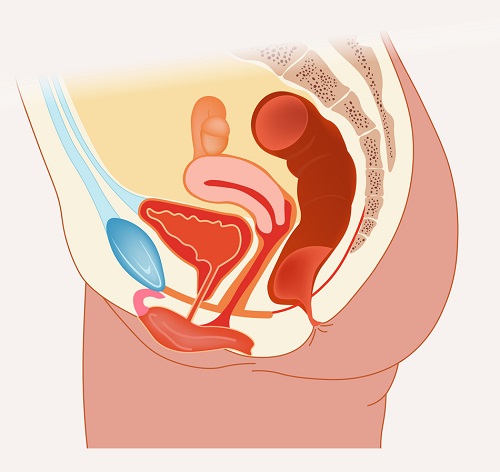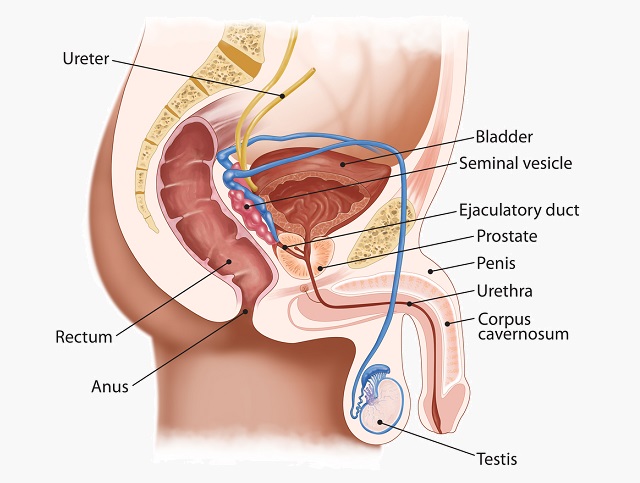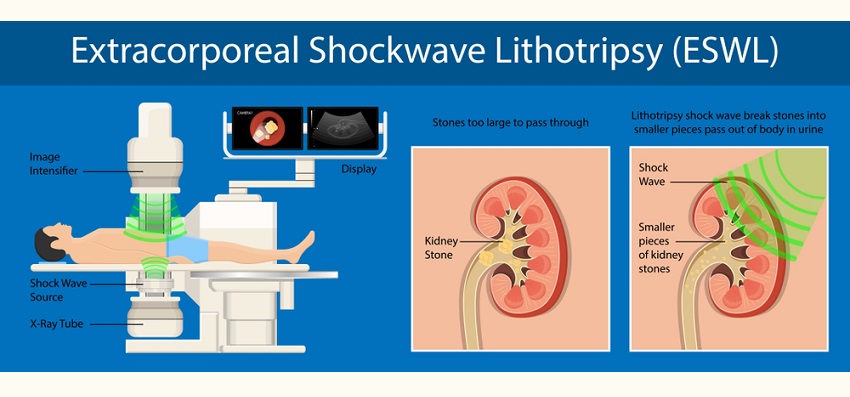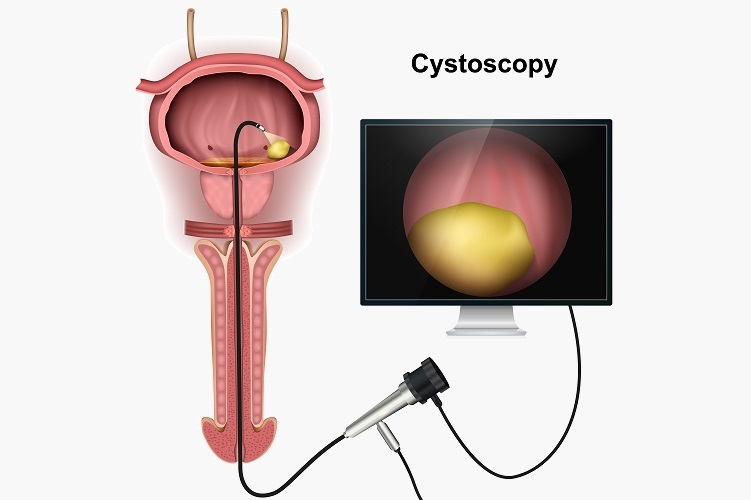Definition
The urethra is a hollow tube positioned between the urinary bladder and urinary meatus which takes urine stored in the bladder out of the body. Urethra length differs in human females and males. In males, the urethra allows for the expulsion of both urine and semen. Internal and external urethral sphincter muscles control micturition.
Urethra Function and Structure
In females, the main urethra functions are the transportation of urine out of the body, prevention of urine reflux, and protection against pathogenic bacteria. In males, the urethra has four functions – the expulsion of urine, the expulsion of sperm, the prevention of either of these fluids from traveling back into the lower urinary tract, and protection against bacteria entering from outside of the body.
The lumen of the urethra of both genders is surrounded by a layer of stratified columnar epithelium. This epithelium layer is protected from the high acidity environment of the urethra by mucus which also keeps the urethra moist and supple. The next layer that makes up the urethral wall is the mucus-secreting submucosa or spongy coat. This layer is surrounded by an inner longitudinal muscle, which is itself surrounded by an outer circular muscle. This combination of longitudinal and circular muscles provides stronger contraction power.
Urethral Sphincter Control
The urethra of both sexes has two sphincter muscles that close off the passage of urine. The first – the internal urethral sphincter or IUS – is composed of smooth (involuntary) muscle fibers internally and striated muscle fibers externally. The smooth muscle layer is a continuation of the detrusor muscle of the bladder. The EUS is kept tight around the urethra through the involuntary control of the sympathetic (fight or flight) nervous system via α-adrenergic excitatory receptors in the urethra and bladder neck. This excitation keeps the internal sphincter closed.
Before micturition, the parasympathetic nervous system takes over and relaxes the internal urinary sphincter. This is done via the release of acetylcholine which relaxes the IUS. At the same time, other neurotransmitters excite the detrusor muscle, causing the bladder to contract.
The second sphincter is the external urethral sphincter (EUS), composed of striated muscle fibers. In males, the EUS is found at the membranous urethra; in females, in the middle third of the short urethra. The somatic (voluntary) external urinary sphincter is controlled by the pelvic splanchnic nerves (or nervi erigentes) emerging at S2, S3, and S4 of the sacral plexus. This set of nerves forms a single bundle and joins the inferior hypogastric plexus at either side of the rectum. They contain both sympathetic and parasympathetic fibers. The nervi erigentes innervate a whole range of muscles located in the colon, rectum, ureters, prostate gland, urinary bladder, urethra, and penis. The branch of these nerves that controls the urethra, among other muscles, is the pudendal nerve. It is this nerve that keeps the external urethral sphincter tight around the urethra.
The combined pressure of both urethral sphincters is higher than that of the bladder and means that urine does not leak through. When the bladder is full and the person in question chooses to urinate, the pudendal nerve relaxes the levator ani muscle – part of the pelvic floor – which opens the external sphincter, at the same time sending a message to the internal sphincter to relax.
In babies and children up to approximately five years old, urination is an involuntary action controlled by various complex nervous pathways. After nerve injury, disease or degeneration, some adults may regress to the involuntary micturition nervous pathways of young children.
Female Urethra
As already mentioned, the female urethra is short – approximately 4 cm long. It lies behind the symphysis pubis, ending just above the vaginal opening and below the clitoris. In the image, from left to right, are the pubis (blue), bladder (red and orange) connecting via a short urethra to the labia, the vagina and uterus, and the rectum.

In females, the urethra is composed of three parts: the internal sphincter, the urethrovaginal muscle, and the external sphincter, often called the compressor muscle as in females the urethra is kept compressed against the vagina in the absence of micturition. The EUS encircles both the urethra and the vagina. Arterial blood supply is provided by the internal pudendal arteries and the vaginal arteries. Venous drainage is provided by the internal pudendal veins and the vaginal veins.
At the end of the female urethra, two mucous glands called Skene glands can be found. These are homologous to the male prostate and secrete lubricants, possibly providing an additional protective barrier against infection via the urethral opening.
Childbirth often damages the muscles of the pelvic floor and pelvic ligaments, while natural birth via the birth canal can damage the pudendal nerve. Both situations can cause incontinence – both urinary and fecal – of varying degrees.
Male Urethra
The male urethra is also comprised of three segments but is much longer than that of the female – approximately 22 cm. The first section of the male urethra is known as the prostatic urethra and begins at the bladder neck, continuing until it meets the prostate gland. Ejaculatory ducts which contain a mixture of semen produced by the testes, alkaline fluid produced by the prostatic ducts, and seminal fluid produced by seminal vesicle glands empty into this section of the male urethra. In the image below, semen transportation is indicated in blue and the urethra in brown.

The membranous urethra travels through the EUS, then through the pelvic floor and deep perineal pouch. This part of the urethra is narrow and less supple when compared to the other two sections so it is more likely to get blocked by stones. While the external urethral sphincter of the female involves both urethra and vagina, that of the male only encircles the urethra.
The spongy urethra or penile urethra travels through the center of the penis, through the bulb and corpus spongiosum, and terminates at the meatus or external urethral orifice. Bulbourethral or Cowper’s glands feed into this part of the urethra, producing and providing extra fluids to make ejaculation easier. Where the urethra goes through the glans, it dilates. This dilated section is called the navicular fossa.
Blood supply to the prostatic urethra is provided by the inferior vesical artery. The membranous urethra and spongy urethra are supplied by branches of the internal pudendal artery.
The prostate gland surrounds the urethra, and prostate enlargement – either benign or malignant – can push the opposite lumen walls of the urethra together, causing stenosis. Severe enlargement often requires a surgical prostatectomy.
Urethra Pain
Urethra pain is a common symptom as the entire urinary system is extremely well innervated. Inflammation, infection, spasm, stenosis, or blockage can cause significant urethral discomfort. This can be experienced as consistent, in waves, or during urination. It can be dull or cause extreme agony. The type of pain can often indicate the cause.
Urolithiasis
Often referred to as kidney stones, the partial or complete blockage of the urethra by crystallized minerals is a common occurrence. The correct term for urinary stones is urolithiasis. Low water intake combined with high salt levels represents ideal conditions for the salt crystallization process. Stones are usually small and leave the body during micturition. Slightly larger stones can temporarily lodge in the collecting ducts, ureters or urethra before being flushed away. Larger stones can completely block off the urine supply and create high pressures in the structures that lie above the stone.

There are five main types of urinary stone, named after the minerals they contain. All of them form more quickly when water intake is low. Calcium oxalate (CAOX) stones are the most common. Ideal conditions for CAOX stones are high levels of calcium and oxalic acid, or high levels of calcium and uric acid. Calcium phosphate stones are the result of calcium and phosphoric acid and occur in the presence of, and excess, of these two minerals. Uric acid stones consist of the broken down units of DNA and RNA. Uric acid crystals form in the acidic urine of diabetics, the obese, and kidney patients. Struvite stones are the result of bacteria interacting with magnesium and phosphate in the urine. Undercooked and raw foods can introduce these bacteria which then enter the urinary tract, usually via the anus. Cystine stones are only found in people suffering from cystinuria, an inherited condition where high levels of the amino acid cysteine enter the nephrons and may crystallize into cystine stones. Two cysteine molecules make a cystine molecule. Stones grow very quickly and their formation can begin in childhood.
Urinary Tract Infections
Urinary tract infections are primarily caused by the transfer of E. Coli bacteria from the area around the anus into the distal opening of the urethra. Due to the shorter length of the urethra in females, cystitis or infection of the bladder is much more common than in males.

A urinary tract infection can be upper or lower, according to the areas of the urinary system that are infected. Infections of the kidney and ureters are upper urinary tract infections, those of the bladder and urethra are lower UTIs. However, all urinary tract infections can spread, affecting the entire system.
Upper Urinary Tract Infections
Nephritis is a term generally used to indicate an infected kidney, with various types indicating which type of tissue is affected. Infections can be either acute or chronic. As with all types of infection, immune deficiency or auto-immune diseases increase risk. Upper urinary tract infections are usually caused by pathogens entering the urethra.
Because the kidneys are responsible for filtration and receive high blood flow, they are more susceptible to infection than most organs. When the immune system is too late, too undeveloped (young children), too slow (the elderly) or too damaged to respond, or if there is a fault within the immune system itself, foreign antigens are given the opportunity to flourish, causing an infection. In the case of lower UTIs or ascending lower UTIs that reach the upper urinary tract, the most common patients are sexually-active young women.
Glomerulonephritis (GN) is an infection of the bundle of capillaries partially surrounded by the horseshoe-shaped Bowman’s capsule of the nephron. An infection here is less likely to be caused by E. Coli and more often the result of a streptococcal infection that enters the blood via the mouth or throat. Because less blood is passed into the nephron due to damaged capillaries and outer cells of the Bowman’s capsule, and because the infection causes leakage and allows larger molecules and blood cells to enter the urinary system, GN symptoms include bloody urine, protein in the urine, and oliguria (low excretion levels of urine). Because the kidney function is affected, edema – the result of water retention – in the face, lower limbs and lungs can occur. Chronic forms of GN begin slowly, giving the body time to adjust and can be asymptomatic until the disease causes permanent damage. Untreated GN can lead to kidney failure.
Interstitial nephritis and tubular nephritis are generally grouped under the term tubulointerstitial nephritis. Proteinuria, hematuria, and pyuria are present in most cases. Rashes are an observable symptom, particularly in interstitial infections. Oliguria, nausea, and malaise are also possible, but patients may be completely asymptomatic. As with all infections of the upper urinary tract, rapid diagnosis is critical in order to prevent the destruction of non-regenerating nephrons and kidney failure.
Pyelonephritis relates to an infection caused by pathogens carried in via the high blood flow, by an ascending urinary tract infection – usually E. Coli – which has entered via the urethra, through vesicoureteral reflux where the junction of ureter and urinary bladder make it possible for urine to flow backward, or through a partial or complete blockage of the urinary system which causes urine to remain stagnant (urinary stasis) within the upper urinary tract. Pyelo means pus, and in this type of infection pus is found within the tubules and ducts and eventually in the urine. The most common triad of symptoms is fever, pain in the flank of one or both sides, and nausea or vomiting. In women, cystitis is usually a co-existing feature.
Lower Urinary Tract Infections
Lower UTIs include urethritis and cystitis. Prostatitis is also included within the group of lower urinary tract infections. As already mentioned, most of these pathologies are caused by the transmission of bacteria from the anus.
An inflamed urethra causes pain during the expulsion of frequent but small volumes of urine (pollakiuria). Pollakiuria is the primary symptom of urethritis. When bacteria ascend through the urethra they can reach the bladder and cause cystitis. Due to the much shorter urethra in the female gender, cystitis is usually a female complaint. Urine testing usually shows the presence of pathogenic bacteria. Prostatitis, unlike the other UTIs, often presents with fever and is considered a medical emergency.
All untreated UTIs can potentially ascend into the upper urinary tract, causing more complicated infections and kidney damage.
Sexually Transmitted Diseases
Also known as STDs and venereal disease (VD), sexually transmitted diseases are passed from one sexual partner to the other. In males, transmission occurs via the urethra, rectum, and mouth. In females, transmission routes are the vagina, urethra, rectum, and mouth. Pathogens include viruses, yeasts, and parasites. Some diseases are asymptomatic; some cause urinary tract infections and infertility. Many cause burning or itchy sensations and inflamed tissues, while a handful are potentially fatal. Multiple partners and unprotected sexual activity are risk factors.

Urethral Syndrome
When the symptoms of a lower urinary tract infection are present but no bacteria or pus is found in a urine sample, urethral syndrome is the most likely diagnosis. The causes can be undetected pathogens or non-infective, where the position of anatomical features, trauma, comorbidities, and allergies might play a role. Even then, treatment is often initiated with antibiotics as the diagnosis is hard without thorough diagnostic testing. Most sufferers are female and symptoms include dysuria (burning sensations and pain when urinating) and pollakiuria.
Urethra Disorder Treatments
In lower UTIs, urethra disorder treatments usually involve antibiotics when caused by bacterial infections. Urethral stenosis or urethral stricture – a narrowing of the lumen caused by swelling, scar tissue or congenital abnormalities – may require dilation. Dilation involves the insertion of gradually larger wires until the lumen is wide enough to allow the passage of urine.
A urethroplasty is the removal of a section of the urethra or its enlargement using other tissues such as skin. This can permanently solve a case of urethral stenosis. A urethrotomy describes the surgical procedure in which the urethra is incised, loosening the stricture.
Stone removal from within the urethra is usually performed using extracorporeal shock wave lithotripsy (ESWL) to break up the stones. Shock waves are sound waves traveling faster than the speed of sound, creating the equivalent of a sonic boom. This disintegrates stones into smaller pieces. Pregnant women can not undergo this procedure due to the use of X-rays over a period of 30 to 60 minutes.

Urethral Stents
Small hollow tubes can be inserted into the urethra to temporarily relieve blockages before surgery or other treatment of the cause. This is not a cure in itself but lowers complication rates caused by pressure buildup in the upper urinary tract. In palliative patients suffering from a narrowing of the urethra lumen where corrective surgery is not an option, a urethral stent increases comfort.
Urethra Insertion
Urethra insertion or urethral insertion is the insertion of a medical probe or sexual stimulation object into the urethra.
In medical settings, a urethroscope is inserted into the distal opening of the urethra in order to visualize the lumen. This diagnostic test can evaluate a patient presenting with dysuria, incontinence, hematuria, urethral pain in the absence of a UTI, palpable masses or recurrent infection. A urethroscope or cystoscope, the latter of which involves the insertion of a lens through the urethra and into the urinary bladder, includes a flushing mechanism to enable washing and drainage and a fiber optic light source. Urethroscopy and cystoscopy must be done in sterile conditions to avoid infection. The procedure can be uncomfortable and lidocaine gel is often applied to the urethra beforehand.

In home settings, insertion of sex toys into the urethra can cause damage to the lining and introduce bacteria, causing UTIs.
Quiz
